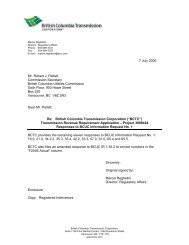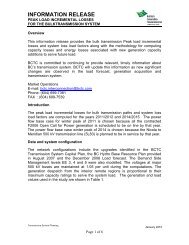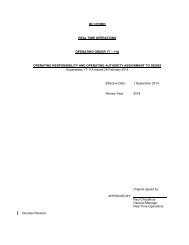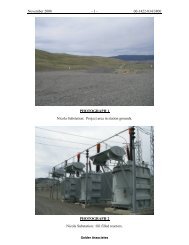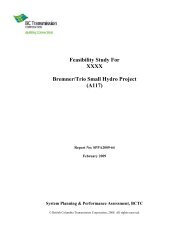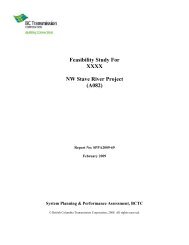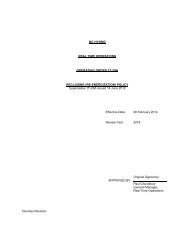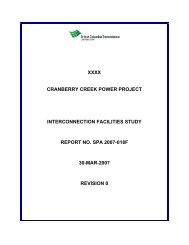Evidence on the Adequacy of First Nations Consultation - BC Hydro ...
Evidence on the Adequacy of First Nations Consultation - BC Hydro ...
Evidence on the Adequacy of First Nations Consultation - BC Hydro ...
You also want an ePaper? Increase the reach of your titles
YUMPU automatically turns print PDFs into web optimized ePapers that Google loves.
DRAFT REPORT: Rights and Title Interests in <strong>the</strong> Columbia Valley Transmissi<strong>on</strong> Project Area<br />
2.3.2 Fishing<br />
The most important species obtained in this regi<strong>on</strong> was salm<strong>on</strong>. The people would make <strong>the</strong>ir<br />
first camp in August, at Brisco <strong>on</strong> <strong>the</strong> Columbia River, and after taking salm<strong>on</strong> <strong>the</strong>re for a while,<br />
would move up <strong>the</strong> Columbia to <strong>the</strong> fishing site near Fairm<strong>on</strong>t Hot Springs. 221 Here <strong>the</strong> salm<strong>on</strong><br />
runs were <strong>of</strong> some size and good quality in August and September, but by October were<br />
declining both in c<strong>on</strong>diti<strong>on</strong> and in numbers. The salm<strong>on</strong> fishing seas<strong>on</strong> ended with a small catch<br />
made at <strong>the</strong> site <strong>of</strong> Athalmer 222 (near Invermere) where a weir was c<strong>on</strong>structed to catch <strong>the</strong><br />
salm<strong>on</strong>. 223 In former times, <strong>the</strong> Michel Prairie people occasi<strong>on</strong>ally fished <strong>the</strong> fall run <strong>of</strong> salm<strong>on</strong><br />
in <strong>the</strong> Columbia Lakes area. 224 Reports <strong>of</strong> locals n<strong>on</strong>-Aboriginal Kootenay residents interviewed<br />
prior to 1940 stated that it was spring (Chinook) salm<strong>on</strong> that were <strong>on</strong>ce plentiful <strong>on</strong> <strong>the</strong> upper<br />
Columbia and that <strong>the</strong>y spawned in beds by Athalmar and <strong>the</strong> Columbia Lakes. It was “not<br />
uncomm<strong>on</strong> to observe some fifty teepees <strong>of</strong> <strong>the</strong> Indians <strong>on</strong> <strong>the</strong> flats <strong>of</strong> Athalmer, who took large<br />
numbers <strong>of</strong> salm<strong>on</strong> <strong>of</strong>f <strong>the</strong> salm<strong>on</strong> beds for <strong>the</strong>ir winter food.” 225<br />
221 This fishing site was identified by Schaeffer (1934-1969, Reel 2) elsewhere in his notes as “kakasítłuk”<br />
(?) meaning ‘mouth <strong>of</strong> river’ and referring to <strong>the</strong> site where Dutch Creek “empties into Columbia, not far from<br />
Fairm<strong>on</strong>t Springs.” Present-day topographical maps indicated that Dutch Creek actually enters into <strong>the</strong> west side <strong>of</strong><br />
<strong>the</strong> north end <strong>of</strong> Columbia Lake, about 5 Km south from Fairm<strong>on</strong>t Hot Springs. This site, Schaeffer added, was<br />
where <strong>the</strong> Columbia Lakes people fished salm<strong>on</strong> in September, following <strong>the</strong>ir fishing at Brisco [and at Toby<br />
Creek]. As well, Schaeffer noted <strong>the</strong>re was a camp site here. See also Schaeffer 1940, page 41. Ano<strong>the</strong>r site that is<br />
likely in this general area that was identified by Schaeffer (1934-1969, Micr<strong>of</strong>ilm No. 2) as a salm<strong>on</strong> fishing site <strong>of</strong><br />
<strong>the</strong> Columbia Lakes people was “kołwa . ákak” (?) meaning ‘berries <strong>of</strong> rosebush’ [wild rose]. This was a site “<strong>on</strong><br />
north side <strong>of</strong> Geary Creek, where it empties into Columbia.” Schaeffer stated that <strong>the</strong> Columbia Lakes people<br />
speared salm<strong>on</strong> here, and that <strong>the</strong>re was a camp site here. However, it has not been possible to find “Geary Creek”<br />
<strong>on</strong> any map reviewed to date.<br />
222 See also Schaeffer 1940, page 41. Schaeffer (1934-1969, Reel 2) elsewhere in his fieldnotes identified<br />
this fishing site near Athalmer as “koatákanuk” (?) meaning ‘where lake empties into river.’ Schaeffer noted this<br />
was a shallow place where <strong>the</strong> salm<strong>on</strong> spawned, that it was <strong>the</strong> last site where <strong>the</strong> Columbia Lakes people fished, in<br />
October, and that <strong>the</strong>re was a camp site here.<br />
223 Schaeffer 1934-1969, Reels 1 and 2<br />
224 Schaeffer 1934-1969, Reels 1 and 2; Schaeffer 1982, page 6. Like <strong>the</strong> “kátamukinik” people, <strong>the</strong> Michel<br />
Prairie people are said to have been almost entirely wiped out by <strong>the</strong> 1781-1782 smallpox epidemic (Schaeffer 1982,<br />
pp. 4, 8-9).<br />
225 Letter <strong>of</strong> C.H. Robins<strong>on</strong>, Fishery Supervisor, to Director, Pacific Biological Stati<strong>on</strong>, 9 May 1940. The<br />
Director forwarded a copy <strong>of</strong> <strong>the</strong> letter to Claude Schaeffer <strong>on</strong> 14 May 1940. It is now am<strong>on</strong>g <strong>the</strong> papers <strong>of</strong> <strong>the</strong><br />
Schaeffer collecti<strong>on</strong> (1934-1969, Reel 1).<br />
Bouchard & Kennedy Research C<strong>on</strong>sultants Page 53<br />
Page 56 <strong>of</strong> 200






